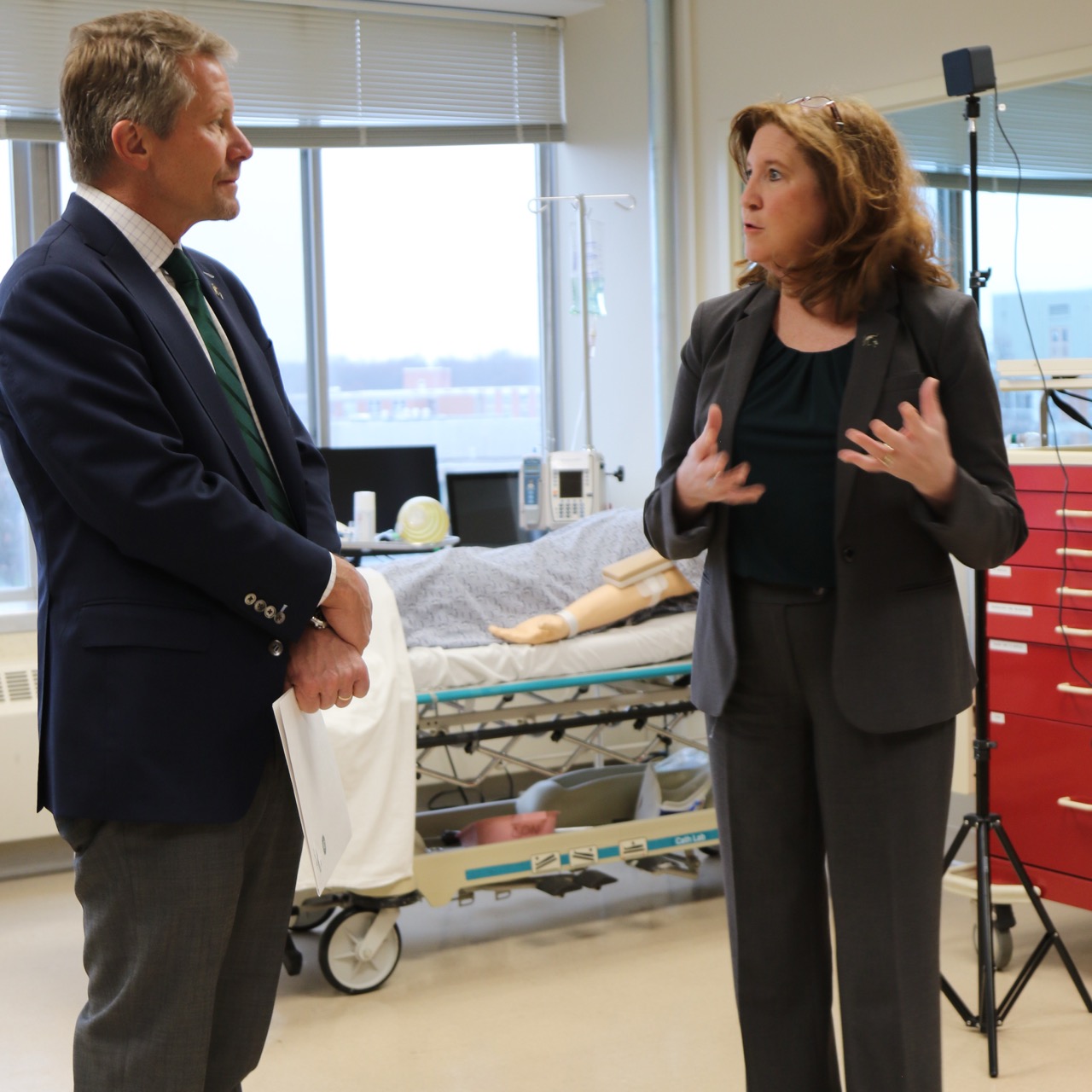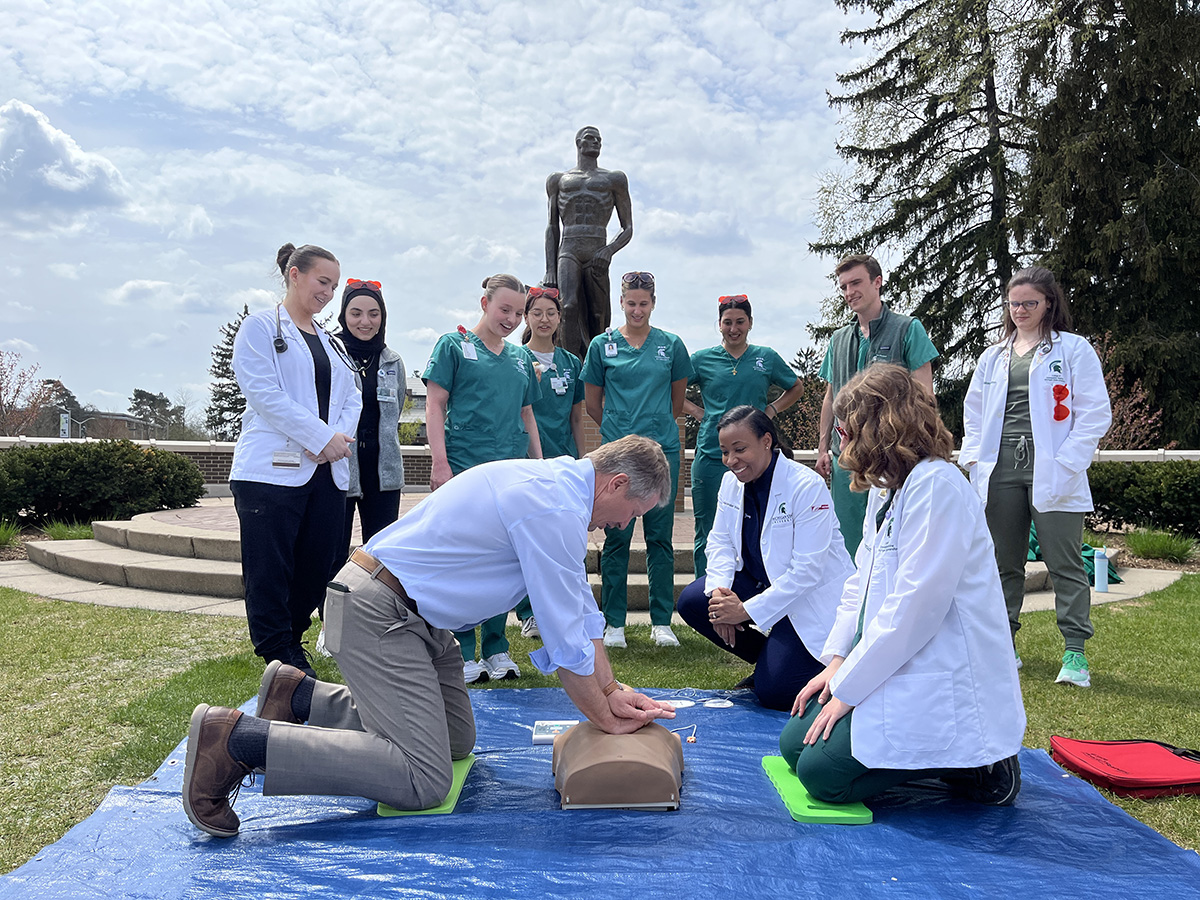
Walk into the MSU Learning and Assessment Center, one of the Michigan State University College of Osteopathic Medicine’s (MSUCOM) simulation sites, and it doesn’t take long to realize this isn’t your average classroom. It looks and feels like a real hospital: monitors beeping, oxygen masks at the ready, a “patient” hooked up to IVs. But what you’re seeing is more than a replica. It’s a critical part of how MSUCOM trains future osteopathic physicians and PAs.
“When people ask me what one of the most important spaces in a medical school is, I always say the simulation center,” said Mary Kay Smith, Ph.D., MSN-Ed, RN, CHSE, FSSH, executive director of the MSU Learning and Assessment Center (LAC). “This is where it all comes together, the knowledge, the hands-on skills, the decision-making, the human connection.”
Osteopathic medicine is all about the human connection.
Simulation is built into the heart of MSUCOM’s Doctor of Osteopathic Medicine (D.O.) curriculum, from the first semester through clinical years. One of the first medical schools to be accredited, MSU benefits from all of its medical schools – the Colleges of Osteopathic Medicine, Human Medicine, Veterinary Medicine and Nursing. MSU’s Learning and Assessment Center (LAC) is the first in Michigan, in the Big Ten and one of the very first to be recognized internationally for integrating methodologies after its recent accreditation by the Society for Simulation in Healthcare (SSIH) for its innovative, unique approach to simulation. Students learn to perform physical exams, deliver difficult news and respond to critical emergencies – all before they ever step into a real hospital.
“You don’t want learners practicing some skills on real patients,” Smith said. “This is why students use simulated patients instead of actual patients, as they learn crucial medical skills.”

"Stayin' alive": MSU's President Kevin M. Guskiewicz practiced delivering CPR to the beat of the popular Bee Gees track with D.O. students from the MSU College of Osteopathic Medicine. This health training event was hosted by MSU's Learning and Assessment Center, partnering with the MSU Colleges of Human Medicine and Nursing, as well as the American Heart Association - Michigan.
That safe, realistic environment does more than just boost student confidence — it plays a vital role in maintaining MSUCOM’s accreditation with the Commission on Osteopathic College Accreditation (COCA).
“High-quality simulation is no longer optional — it’s critical in contemporary medical education,” Smith emphasized. “Accreditation ensures that we’re delivering consistent, excellent educational activities which translate to safer quality of care. It’s our contract with the public. It says: we don’t just claim to produce compassionate, competent doctors… we deliver.”
Accreditation standards mandate not just the presence of simulation spaces, but the quality and integration of their use. At MSUCOM, that means simulation isn’t a standalone feature, it’s woven throughout the learning journey. Faculty use it to assess real-time decision-making, communication under stress and even ethical reasoning.
“We don’t just want students who can memorize clinical guidelines,” Smith said. “We want them to be able to respond under pressure, think critically and connect with their patients holistically. Simulation helps shape those instincts.”
“Our students don’t wait until their third year to begin interacting with patients — they’re doing it right from the start,” Smith explained. “Sometimes those ‘patients’ are mannequins, but they’re incredibly lifelike. They blink, breathe, go into cardiac arrest, even give birth.”
The teaching doesn’t just come from human simulators. The LAC employs standardized patients — real people trained to simulate real-world medical conditions and emotional responses. These encounters challenge students not only to use technical skills but to listen, connect and build trust.
“You can’t memorize empathy,” Smith said. “Learners need to practice and apply it. Simulation gives students that space to make mistakes, reflect and improve. If something goes awry in simulation, it’s a learning opportunity, not a tragedy.”
During the COVID-19 pandemic, when many clinical training sites closed, the Learning and Assessment Center quickly adapted. Scenarios went virtual. Telehealth simulations were introduced with standardized patients connecting with learners via Zoom.
“We didn’t stop training,” Smith said. “We got more creative. Simulation gave us the flexibility to keep our students engaged, safe and their academic progression was not compromised. Interestingly, the use of standardized patients for telehealth training has not decreased post-pandemic.”
That flexibility also serves MSUCOM’s broader mission. Students train at partner hospitals and clinics across Michigan, rural and urban alike. Simulation ensures every student receives the same foundation, no matter where they complete their rotations.
“Simulation is also about equity and standardization,” Smith added. “It guarantees all our students have access to high-quality clinical experiences. That matters, because they’re going to practice in every kind of setting and they need to be ready.”
From the first awkward blood pressure check to managing a cardiac arrest in real time, students grow in ways that can’t be measured by test scores alone. It’s that transformation, from nervous learner to confident, compassionate caregiver that Smith finds most rewarding.
“It’s a lot of work — coordinating, training, running scenarios — but it’s worth it,” she said. “Every time I see a student go from unsure to steady, from textbook knowledge to real-life care, it reinforces why we invest in it.”
By Jim Peck
Walk into the MSU Learning and Assessment Center, one of the Michigan State University College of Osteopathic Medicine’s (MSUCOM) simulation sites, and it doesn’t take long to realize this isn’t your average classroom. It looks and feels like a real hospital: monitors beeping, oxygen masks at the ready, a “patient” hooked up to IVs. But what you’re seeing is more than a replica. It’s a critical part of how MSUCOM trains future osteopathic physicians and PAs.
“When people ask me what one of the most important spaces in a medical school is, I always say the simulation center,” said Mary Kay Smith, Ph.D., MSN-Ed, RN, CHSE, FSSH, executive director of the MSU Learning and Assessment Center (LAC). “This is where it all comes together, the knowledge, the hands-on skills, the decision-making, the human connection.”
Osteopathic medicine is all about the human connection.
Simulation is built into the heart of MSUCOM’s Doctor of Osteopathic Medicine (D.O.) curriculum, from the first semester through clinical years. One of the first medical schools to be accredited, MSU benefits from all of its medical schools – the Colleges of Osteopathic Medicine, Human Medicine, Veterinary Medicine and Nursing. MSU’s Learning and Assessment Center (LAC) is the first in Michigan, in the Big Ten and one of the very first to be recognized internationally for integrating methodologies after its recent accreditation by the Society for Simulation in Healthcare (SSIH) for its innovative, unique approach to simulation. Students learn to perform physical exams, deliver difficult news and respond to critical emergencies – all before they ever step into a real hospital.
“You don’t want learners practicing some skills on real patients,” Smith said. “This is why students use simulated patients instead of actual patients, as they learn crucial medical skills.”

"Stayin' alive": MSU's President Kevin M. Guskiewicz practiced delivering CPR to the beat of the popular Bee Gees track with D.O. students from the MSU College of Osteopathic Medicine. This health training event was hosted by MSU's Learning and Assessment Center, partnering with the MSU Colleges of Human Medicine and Nursing, as well as the American Heart Association - Michigan.
That safe, realistic environment does more than just boost student confidence — it plays a vital role in maintaining MSUCOM’s accreditation with the Commission on Osteopathic College Accreditation (COCA).
“High-quality simulation is no longer optional — it’s critical in contemporary medical education,” Smith emphasized. “Accreditation ensures that we’re delivering consistent, excellent educational activities which translate to safer quality of care. It’s our contract with the public. It says: we don’t just claim to produce compassionate, competent doctors… we deliver.”
Accreditation standards mandate not just the presence of simulation spaces, but the quality and integration of their use. At MSUCOM, that means simulation isn’t a standalone feature, it’s woven throughout the learning journey. Faculty use it to assess real-time decision-making, communication under stress and even ethical reasoning.
“We don’t just want students who can memorize clinical guidelines,” Smith said. “We want them to be able to respond under pressure, think critically and connect with their patients holistically. Simulation helps shape those instincts.”
“Our students don’t wait until their third year to begin interacting with patients — they’re doing it right from the start,” Smith explained. “Sometimes those ‘patients’ are mannequins, but they’re incredibly lifelike. They blink, breathe, go into cardiac arrest, even give birth.”
The teaching doesn’t just come from human simulators. The LAC employs standardized patients — real people trained to simulate real-world medical conditions and emotional responses. These encounters challenge students not only to use technical skills but to listen, connect and build trust.
“You can’t memorize empathy,” Smith said. “Learners need to practice and apply it. Simulation gives students that space to make mistakes, reflect and improve. If something goes awry in simulation, it’s a learning opportunity, not a tragedy.”
During the COVID-19 pandemic, when many clinical training sites closed, the Learning and Assessment Center quickly adapted. Scenarios went virtual. Telehealth simulations were introduced with standardized patients connecting with learners via Zoom.
“We didn’t stop training,” Smith said. “We got more creative. Simulation gave us the flexibility to keep our students engaged, safe and their academic progression was not compromised. Interestingly, the use of standardized patients for telehealth training has not decreased post-pandemic.”
That flexibility also serves MSUCOM’s broader mission. Students train at partner hospitals and clinics across Michigan, rural and urban alike. Simulation ensures every student receives the same foundation, no matter where they complete their rotations.
“Simulation is also about equity and standardization,” Smith added. “It guarantees all our students have access to high-quality clinical experiences. That matters, because they’re going to practice in every kind of setting and they need to be ready.”
From the first awkward blood pressure check to managing a cardiac arrest in real time, students grow in ways that can’t be measured by test scores alone. It’s that transformation, from nervous learner to confident, compassionate caregiver that Smith finds most rewarding.
“It’s a lot of work — coordinating, training, running scenarios — but it’s worth it,” she said. “Every time I see a student go from unsure to steady, from textbook knowledge to real-life care, it reinforces why we invest in it.”
By Jim Peck
